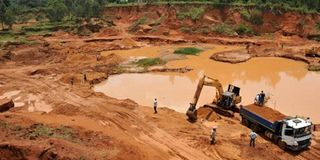Sand mining in Lwera and restoration of the landscape

What you need to know:
Soil degradation. We are damming more rivers and diverting many more as we develop irrigation schemes. In a way, we are increasingly starving the lakes, because sediments are either retained in reservoirs behind dams or lost mid-stream.
In the last quarter of 2016, so much attention was drawn to sand mining activities in Lwera, mostly because of the visible signs of dereliction – large ponds taken over by invasive plants, and heaps of over-burden dotting formerly mined areas. The inquisitive members of society wondered what this meant to dependent systems, such as Lake Victoria, and many wondered whether it is even possible to restore the landscape in a manner that can help it regain its functionality.
For starters, we are yet to understand the effects of what we see on the unseen. In the absence of such knowledge, we have been left with no option, but to conceptualise the impacts following events reported elsewhere. Unfortunately, much of the literature describes scenarios for unrelated systems, although this helps to shape scientific opinion and guide responses.
The question as to whether the landscape can be restored to near its natural state depends on what we call natural. What is natural depends on the circumstance, which is itself dependent upon the time element of ecological processes and forcing. A natural forcing can elevate or degrade a system so much so that it changes its character to a quasi-stable state lasting ages, and giving an impression of “natural” to the human eye – simply because of our limited lifespan in respect to the ecosystems, we are a part of.
So, benchmarking restoration is a tight call.
This is not to say that it is not possible to “restore” ecological systems. What I think is important is to focus on assisting landscape recovery, and hence the use of the term “landscape rehabilitation”. This is a very convenient concept because ecological recovery timelines need not to be tied to fiscal calendars. The system is assisted by focusing on the most important components to kick-start recovery.
Doing this requires good knowledge of the system, and its main drivers, and never should one speculate like some people seem to be doing with sand mining in Lwera wetland. I have come across statements like sand will regenerate! Some people have even told us that the next huge rains will wash sand bank to Lwera. What they have not told you is where the sand is going to come from. To them, Lake Victoria has so much sand that a heavy storm will increase its level, wave energy, and hence deposition of sand in Lwera and surrounding areas.
A quick review of historical soil literature for Uganda (e.g. Radwanski’s Memoirs of the Research Division, Series 1 – Soils, published in the late 1950s), and publications of Uganda’s Department of Geologic Survey and Mines, show that the sand deposits around Lake Victoria are of Pleistocene to recent age, and that part of these are the former beach and littoral areas of the lake. The spatial extent of these areas seems to have varied as the lake responded to drying and wetting episodes experienced in its 400,000+ years of existence.
Imprints of these events are in the profiles of soils just around the lake – portions of the land around the lake have sand deposits sandwiched by layers of clay-rich soils to depth; testimony that, every so often in its existence, the receding lake left deposits on land, which were modified by the elements before another deposition event. But for this to happen, there must be a source area for sand.
If you think closely about this process, then you get to understand that three things must happen for our sand to regenerate in the way we know it. First, materials have to be supplied from somewhere. Second, for the sediments to be dragged to the lake via the intricate hydrologic lines, there has to be close to no interruptions. Unfortunately, we are damming more rivers and diverting many more as we develop irrigation schemes. In a way, we are increasingly starving the lakes, because sediments are either retained in reservoirs behind dams or lost mid-stream, given that rivers with reduced discharge have no energy to transport the sediments.
Third, once dumped in the lake, there has to be an equivalent rise in lake level and matching energy to grow beach areas. In essence, it is highly probable that the sand we are mining from lacustrine wetlands will not be regenerated in our lifetime.
Dr Lugumira is a natural resource manager (soils & land use) at Nema
[email protected]




